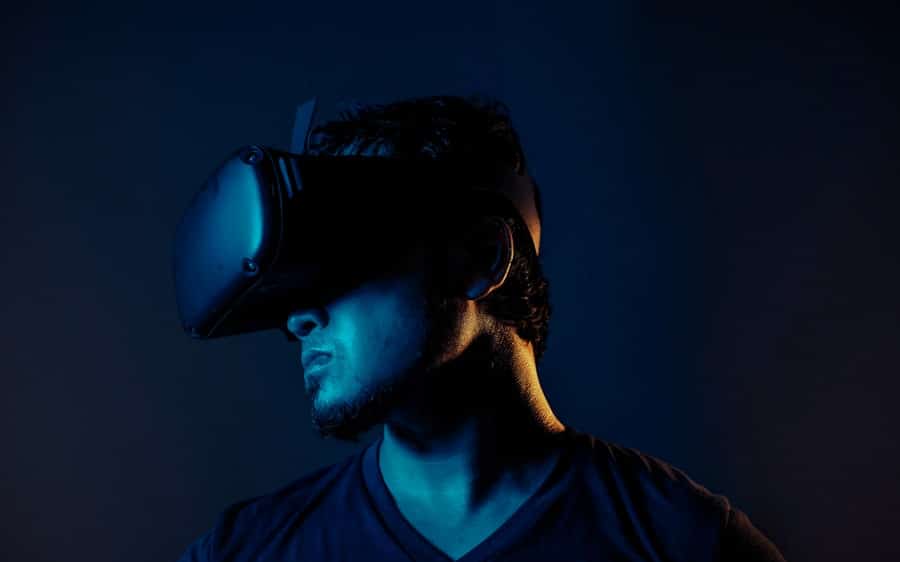The advent of virtual reality (VR) technology has marked a significant turning point in the evolution of online social networks.
However, as technology advanced, the demand for more immersive experiences grew.
The introduction of VR has transformed the landscape, enabling users to engage in a three-dimensional space that mimics real-life interactions. Companies like Facebook, now Meta, have invested heavily in VR, envisioning a future where social interactions occur in virtual environments rather than through traditional screens. The rise of VR in online social networks can be attributed to several factors, including advancements in hardware and software, increased accessibility, and a growing user base that craves more engaging experiences.
The development of affordable VR headsets, such as the Oculus Quest series and HTC Vive, has made it possible for a broader audience to access these immersive environments.
This shift from passive consumption of content to active participation in social experiences has redefined how individuals connect online.
Key Takeaways
- Virtual reality is becoming increasingly popular in online social networks, offering users a more immersive and interactive experience.
- VR has the potential to enhance user engagement and interaction by allowing individuals to connect in a more realistic and immersive environment.
- Creating immersive social experiences in virtual reality can lead to more meaningful and impactful interactions between users.
- VR has the potential to significantly impact online social networking by revolutionizing the way people connect and communicate with each other.
- Despite its potential, integrating VR into online social networks comes with challenges and barriers that need to be addressed for successful implementation.
Enhancing User Engagement and Interaction through VR
Enhanced Interaction and Expression
Unlike traditional platforms, VR enables users to interact with each other in real-time, using their avatars to convey emotions and body language, adding depth to conversations.
Immersive Experiences
This level of engagement fosters a sense of presence, often lacking in conventional online. Users can participate in virtual concerts, meetups, or other events, interacting with others as if physically present. Moreover, VR facilitates collaborative experiences
Users can work together on projects, play games, or explore virtual worlds collectively, enhancing user engagement and strengthening community bonds. Platforms like AltspaceVR host events, allowing for knowledge sharing and networking opportunities.
Increased Engagement and Community Building
The nature of VR encourages users to spend more time on these platforms, leading to increased interaction and a more vibrant online community.
Creating Immersive Social Experiences in Virtual Reality

The creation of immersive social experiences in virtual reality is a game-changer for online networking. In VR environments, users can design their own spaces, customize their avatars, and create unique experiences that reflect their personalities and interests. This level of personalization fosters a deeper connection between users and their virtual surroundings.
For instance, a user might create a virtual art gallery showcasing their work, inviting friends to explore and discuss the pieces in an interactive setting. Such experiences not only promote creativity but also encourage social interaction around shared interests. Additionally, immersive storytelling plays a crucial role in enhancing social experiences within VR.
Developers are increasingly incorporating narrative elements into virtual environments, allowing users to engage with content in a more meaningful way. For example, platforms like Oculus Venues offer live-streamed events where users can watch performances together while interacting with one another in real-time. This blend of entertainment and social interaction creates a unique atmosphere that traditional social media cannot replicate.
As users navigate these immersive experiences, they forge connections based on shared activities and interests, enriching their social lives.
The Potential Impact of VR on Online Social Networking
The potential impact of virtual reality on online social networking is profound and multifaceted. As VR technology continues to evolve, it is likely to reshape how individuals connect and communicate online. One significant impact is the potential for increased inclusivity.
Virtual reality can provide a platform for individuals who may face barriers in physical social settings—such as those with disabilities or social anxiety—to engage with others in a more comfortable environment. By removing physical limitations, VR opens up new avenues for social interaction that were previously inaccessible. Furthermore, the integration of VR into online social networks could lead to the emergence of entirely new forms of social media.
As users become accustomed to immersive experiences, traditional platforms may need to adapt or risk obsolescence. This shift could result in the development of hybrid platforms that combine elements of VR with existing social media features. For instance, imagine a platform where users can share photos and videos while simultaneously engaging in virtual meetups or events.
Such innovations could redefine the concept of social networking, making it more interactive and engaging than ever before.
Overcoming Challenges and Barriers in VR Integration
Despite the promising potential of virtual reality in online social networks, several challenges and barriers must be addressed for widespread adoption. One significant hurdle is the technological limitations associated with VR hardware and software. While devices have become more affordable, not everyone has access to high-quality VR headsets or the necessary computing power to run immersive applications smoothly.
This disparity could create a digital divide where only certain demographics can fully participate in VR social networks. Another challenge lies in the user experience design of VR platforms. Creating intuitive interfaces that cater to both tech-savvy users and those new to VR is essential for fostering engagement.
Developers must prioritize accessibility features to ensure that individuals with varying levels of technical expertise can navigate these environments comfortably. Additionally, issues related to motion sickness and discomfort during prolonged use must be addressed to enhance user experience and encourage longer engagement periods.
The Role of VR in Shaping the Future of Online Social Connections

As virtual reality continues to gain traction within online social networks, its role in shaping future connections cannot be overstated. The immersive nature of VR has the potential to foster deeper relationships among users by creating shared experiences that transcend geographical boundaries. In a world where remote work and global communication are becoming increasingly common, VR offers a solution for maintaining personal connections despite physical distance.
Moreover, the evolution of VR technology may lead to new forms of social interaction that we have yet to imagine. As developers experiment with different applications and environments, we may see the emergence of entirely new ways for people to connect—be it through virtual travel experiences or collaborative projects that bring together individuals from diverse backgrounds. The possibilities are vast, and as technology continues to advance, so too will the ways we forge connections online.
Ethical and Privacy Considerations in VR Social Networking
With the rise of virtual reality in online social networking comes a host of ethical and privacy considerations that must be addressed. One primary concern is data privacy; as users engage in immersive environments, they generate vast amounts of data related to their interactions and behaviors. Companies must ensure that this data is handled responsibly and transparently to protect user privacy.
The potential for misuse or unauthorized access to personal information raises significant ethical questions about how data is collected, stored, and utilized within these platforms. Additionally, issues related to harassment and toxic behavior within virtual spaces must be taken seriously. Just as traditional social media platforms grapple with these challenges, so too must VR environments implement robust moderation systems to create safe spaces for users.
Developers need to establish clear guidelines for acceptable behavior and provide tools for reporting misconduct within virtual settings. Ensuring a positive user experience while maintaining ethical standards will be crucial for the long-term success of VR social networking.
The Future of VR in Redefining Online Social Networks
Looking ahead, the future of virtual reality in redefining online social networks appears promising yet complex. As technology continues to advance at an unprecedented pace, we can expect further innovations that enhance user experience and engagement within these platforms. The integration of artificial intelligence (AI) could play a pivotal role in personalizing interactions and creating tailored experiences based on individual preferences and behaviors.
Moreover, as more people embrace remote work and digital communication, the demand for immersive social experiences will likely grow. Companies may invest further in developing VR solutions that cater specifically to professional networking or collaborative work environments. This evolution could lead to a new era of online social networking where virtual interactions become as commonplace as face-to-face meetings.
In conclusion, while challenges remain in the integration of virtual reality into online social networks, the potential benefits are immense. As we navigate this evolving landscape, it will be essential for developers, users, and policymakers alike to collaborate on creating inclusive, engaging, and ethical virtual spaces that foster genuine connections among individuals worldwide.
In a recent article on enicomp.com, the top trends on YouTube for 2023 were discussed, highlighting the growing influence of online video content in shaping social networks. As virtual reality technology continues to advance, it is expected to play a significant role in transforming online social interactions. To fully experience the immersive world of VR, users will need powerful devices like the Huawei Mate 50 Pro. For students looking to enhance their online social experiences, choosing the right PC is crucial. By staying informed on the latest trends and technology, individuals can make the most of their virtual reality experiences and online social networks. Read more here.
FAQs
What is VR?
VR stands for virtual reality, which is a computer-generated simulation of an environment that can be interacted with in a seemingly real or physical way by a person using special electronic equipment, such as a helmet with a screen inside or gloves fitted with sensors.
How is VR transforming online social networks?
VR is transforming online social networks by providing users with immersive and interactive experiences, allowing them to interact with others in a more lifelike and engaging manner. This technology has the potential to create more meaningful and authentic connections in the digital space.
What are some potential applications of VR in online social networks?
Some potential applications of VR in online social networks include virtual meetups and events, immersive virtual environments for socializing and gaming, and enhanced communication through avatars and virtual spaces.
What are the challenges and limitations of VR in transforming online social networks?
Challenges and limitations of VR in transforming online social networks include the need for expensive and specialized equipment, potential issues with accessibility and inclusivity, and concerns about privacy and security in virtual environments.
What are the future prospects of VR in transforming online social networks?
The future prospects of VR in transforming online social networks are promising, with continued advancements in technology and the potential for VR to revolutionize the way people connect and interact in the digital world.

